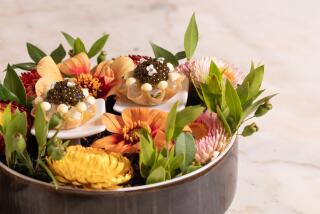Around the World in 85 Years : From Russia to Rutherford: Andre Tchelistcheff Changed the Course of West Coast Wines
Andre Tchelistcheff is one of the world’s most revered and respected wine makers; he’s received virtually every award the wine world has to offer. In September, he was honored at a dinner commemorating his 20 years as enological consultant to Washington state’s Chateau Ste. Michelle--the most outstanding winery of the Pacific Northwest--and the 10th anniversary of the opening of the winery’s handsome facilities in Woodinville, near Seattle. And though he’ll turn 85 on Dec. 7, the diminutive, Moscow-born, deep-voiced Tchelistcheff keeps a schedule that would fatigue most people half his age, traveling to vineyards and wineries at home and abroad.
He was born in 1901 and graduated from the military academy in Kiev. After the collapse of the White Army in the Crimea in 1918, he escaped to Turkey and subsequently earned a degree as an engineer-agronomist at the Institute of National Agronomy in Brno, Czechoslovakia.
But for years, he says, “I was really into animal husbandry, and breeding borzois, those wonderful hunting dogs you call Russian wolfhounds--but not those Art Deco, stylish dogs in pictures. Ours were hunters that raced along with the hussars.”
It wasn’t until the early ‘30s, when Tchelistcheff moved to Paris and did graduate work
at wine and agronomy academies there, that he became interested in viticulture and enology.
In the late spring of 1937, Georges de Latour, the French-born founder of Napa Valley’s Beaulieu Vineyards, arrived in Paris in search of a new wine maker. His inquiries led him to an academy, where he was advised by the director to talk to the brilliant young Tchelistcheff. De Latour was impressed with the articulate, energetic emigre, hired him and arranged for him to come to California. Tchelistcheff’s arrival in Rutherford for the harvest of 1937 would have a far-reaching effect on California wine making.
For Tchelistcheff, 1986 was his 49th vintage in America. He spent 35 years with Beaulieu; since retiring from there, he has worked at an impressive roster of wineries in California and Washington.
Grapes for all Chateau Ste. Michelle wines come from the region around the confluence of the Columbia and Snake rivers, which lies at the same latitude, between 46 and 48 degrees north, as the great wine regions of Bordeaux and Burgundy. Because of this northerly latitude, the Columbia Valley is blessed with more daily sunlight than California’s wine regions. During June, the valley gets an average of 17.4 hours of sunlight; the California average is 15.8 hours. That means more development of grape sugar. The day-to-night temperature difference of 35 degrees protects the equally important acid ratio for perfectly balanced wines. All of this caught Tchelistcheff’s eye 20 years ago.
Winery president Allen Shoup reminisced during dinner about the initial years, recalling then-owner Wallace Opdyke’s goal: “To make this a world-class winery.”
Chateau Ste. Michelle has survived both rough economic times and a severe natural blow--a devastating ice storm in December, 1978. For several months, during the harvesting of some thoroughly botrytised Riesling grapes and the making of a memorable ice-wine, unprecedented weather kept the ground frozen down to the vines’ roots. Only the financial resources of the U.S. Tobacco Co., which had purchased the winery from Opdyke, allowed the winery to survive and to replant the affected acres.
We drank a toast to Tchelistcheff with the winery’s 1975 Cabernet Sauvignon, in glasses inscribed with his signature. The wine--bronzed at the edges to a brick-red and with no trace of tannin--was a majestic realization of the region’s potential. As I savored its finesse, my mind raced to other great clarets of my experience. This wine ranks with the First Growths of great vintages grown in this same latitude but thousands of miles away across the Atlantic.
Tchelistcheff smiled with proud pleasure as we talked about this wine and the next, the 1976. When he had tasted the 1976 from magnums 10 years ago, he had rated it 19 +; tasting it now, he could believe that “this intellectual beverage known as wine” makes “our hearts to shine.” That triggered a recollection of a line uttered by Aeschylus more than 2,000 years ago: “Bronze is the mirror of form; wine, of the heart.”
As we sipped our concluding wine, the Chateau Ste. Michelle 1985 Late Harvest White Riesling Chateau Reserve (not yet released), rich with 12% residual sugar, the botrytis quality rising in bouquet like the perfume of ripe apricots, Tchelistcheff smiled again, his eyes sparkling. “Two years more,” he told Shoup. “Then it will be ready for release.” With a confident tilt of his chin, he added, “You’ll see.”
Shoup beamed and nodded.
Eighty-five years of working wisdom and knowledge had made the decision.
It was a memorable evening--of wine, and heart. Wines of the Week Several current releases of Chateau Ste. Michelle wines are available in Southern California: the 1984 Fume Blanc ($8.50) is crisp, tart, dry, refreshing; the 1983 Chardonnay ($10.50) is full-bodied with a kiss of oak, and buttery-smooth; the 1980 Cabernet Sauvignon Reserve ($18)--packaged in a wooden box--is ready to enjoy now or later and makes an ideal holiday gift.
More to Read
Sign up for Essential California
The most important California stories and recommendations in your inbox every morning.
You may occasionally receive promotional content from the Los Angeles Times.










